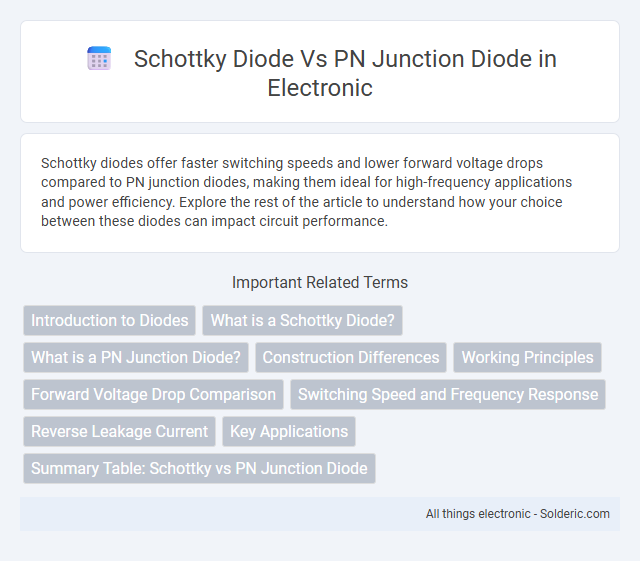Schottky diodes offer faster switching speeds and lower forward voltage drops compared to PN junction diodes, making them ideal for high-frequency applications and power efficiency. Explore the rest of the article to understand how your choice between these diodes can impact circuit performance.
Comparison Table
| Feature | Schottky Diode | PN Junction Diode |
|---|---|---|
| Construction | Metal-semiconductor junction | PN semiconductor junction |
| Forward Voltage Drop | 0.15 - 0.45 V (low) | 0.6 - 0.7 V (higher) |
| Switching Speed | Very fast (nanoseconds) | Slower (microseconds) |
| Reverse Recovery Time | Minimal (fast recovery) | Significant (slow recovery) |
| Leakage Current | Higher leakage current | Lower leakage current |
| Applications | High-speed switching, power rectification, RF circuits | General rectification, voltage regulation |
| Maximum Reverse Voltage | Lower (typically < 100 V) | Higher (up to several hundred volts) |
Introduction to Diodes
Schottky diodes feature a metal-semiconductor junction, offering faster switching speeds and lower forward voltage drop compared to the traditional PN junction diode. PN junction diodes consist of p-type and n-type semiconductor materials, providing higher reverse voltage tolerance but slower response times. Schottky diodes are ideal for high-frequency applications and power rectification, while PN junction diodes are widely used in general-purpose rectification and signal modulation.
What is a Schottky Diode?
A Schottky diode is a semiconductor device formed by the junction of a metal with an n-type semiconductor, creating a low forward voltage drop and fast switching speed compared to a PN junction diode. Unlike the PN junction diode, which relies on the p-type and n-type semiconductor interface, the Schottky diode's metal-semiconductor junction results in minimal charge storage, making it ideal for high-frequency applications and power rectification. Your choice of a Schottky diode over a PN junction diode can improve efficiency in circuits requiring rapid response and low voltage loss.
What is a PN Junction Diode?
A PN junction diode is a semiconductor device formed by joining P-type and N-type materials, creating a junction that allows current to flow primarily in one direction. It operates by enabling electrons to move from the N-region to holes in the P-region when forward biased, resulting in conduction. Your electronic circuits rely on PN junction diodes for rectification, voltage regulation, and signal modulation due to their controlled forward voltage drop and reverse blocking properties.
Construction Differences
Schottky diodes feature a metal-semiconductor junction formed by contacting a metal directly to an n-type semiconductor, resulting in a low forward voltage drop and fast switching speed. In contrast, PN junction diodes comprise a p-type semiconductor joined to an n-type semiconductor, creating a depletion region responsible for their higher forward voltage and slower recovery time. The absence of a depletion region in Schottky diodes gives them distinct electrical characteristics compared to traditional PN junction diodes.
Working Principles
The Schottky diode operates based on the metal-semiconductor junction, where current conduction occurs primarily through majority carriers, resulting in faster switching speeds and lower forward voltage drop (typically 0.15-0.45 V). The PN junction diode relies on the p-type and n-type semiconductor interface, with current flowing via both majority and minority carriers, causing a higher forward voltage drop (approximately 0.7 V for silicon) and slower response time. These fundamental differences in charge carrier mechanisms influence their efficiency, switching speed, and applications in high-frequency and low-voltage circuits.
Forward Voltage Drop Comparison
Schottky diodes exhibit a significantly lower forward voltage drop, typically between 0.15 to 0.45 volts, compared to PN junction diodes, which generally range from 0.6 to 1.0 volts. This lower voltage drop in Schottky diodes results in higher efficiency and reduced power loss, especially in high-frequency and switching applications. Consequently, Schottky diodes are preferred in circuits requiring fast switching and low forward voltage operation.
Switching Speed and Frequency Response
Schottky diodes exhibit significantly faster switching speeds than PN junction diodes due to their metal-semiconductor junction, which eliminates charge storage and reduces recovery time. This characteristic enables Schottky diodes to perform efficiently at high frequencies, often in the GHz range, making them ideal for RF applications and high-speed switching circuits. Your designs benefit from improved frequency response and reduced switching losses when you choose a Schottky diode over a traditional PN junction diode.
Reverse Leakage Current
Schottky diodes exhibit significantly higher reverse leakage current compared to PN junction diodes due to their metal-semiconductor junction, which allows more minority carriers to flow when reverse-biased. PN junction diodes have lower reverse leakage current because of the inherent depletion region formed by the p-n interface, restricting carrier movement under reverse voltage. This makes Schottky diodes faster in switching applications but less suitable for high-voltage environments where lower leakage current is critical.
Key Applications
Schottky diodes are ideal for high-speed switching and low forward voltage drop applications, making them suitable for power rectifiers, RF mixers, and clamping circuits. PN junction diodes excel in general-purpose rectification, voltage regulation, and signal demodulation due to their higher reverse voltage tolerance and slower switching speed. Your choice depends on the required switching speed and voltage characteristics for efficient circuit performance.
Summary Table: Schottky vs PN Junction Diode
A Schottky diode offers faster switching speeds and lower forward voltage drop (typically 0.2 to 0.3 V) compared to a PN junction diode, which usually has a forward voltage drop around 0.7 V. The Schottky diode exhibits higher leakage current and lower reverse voltage rating, while the PN junction diode provides better reverse recovery characteristics and higher reverse voltage tolerance. Your choice depends on the application's need for speed, efficiency, and voltage handling, as summarized in their performance and electrical parameters.
Schottky diode vs PN junction diode Infographic

 solderic.com
solderic.com